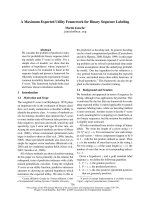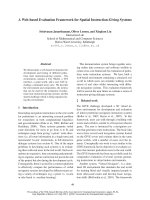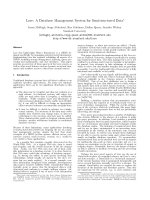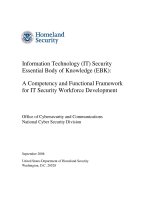Designing a knowledge management system framework for knowledge sharing
Bạn đang xem bản rút gọn của tài liệu. Xem và tải ngay bản đầy đủ của tài liệu tại đây (6.19 MB, 125 trang )
ADDIS ABABA UNIVERSITY
COLLEGE OF NATURAL SCIENCES
SCHOOL OF INFORMATION SCIENCE
DESIGNING A KNOWLEDGE MANAGEMENT SYSTEM
FRAMEWORK FOR KNOWLEDGE SHARING
THE CASE OF ADDIS ABABA LAND HOLDING REGISTRATION AND
INFORMATION AGENCY
ESHETU BIRRU YITEBAREK
Addis Ababa
June 2017
i|Page
ADDIS ABABA UNIVERSITY
COLLEGE OF NATURAL SCIENCES
SCHOOL OF INFORMATION SCIENCE
DESIGNING A KNOWLEDGE MANAGEMENT SYSTEM
FRAMEWORK FOR KNOWLEDGE SHARING
THE CASE OF ADDIS ABABA LAND HOLDING REGISTRATION AND
INFORMATION AGENCY
ESHETU BIRRU YITEBAREK
A Thesis Submitted to the Department of Information Science in Partial Fulfillment
for the Degree of Master of Science in Information Science
June 2017
ADDIS ABABA UNIVERSITY
School of Information Science ii | P a g e
ADDIS ABABA UNIVERSITY
COLLEGE OF NATURAL SCIENCES
SCHOOL OF INFORMATION SCIENCE
DESIGNING A KNOWLEDGE MANAGEMENT SYSTEM
FRAMEWORK FOR KNOWLEDGE SHARING
THE CASE OF ADDIS ABABA LAND HOLDING REGISTRATION AND
INFORMATION AGENCY
A Thesis Submitted to the College of Natural Sciences of Addis Ababa University in
Partial Fulfillment of the Requirements for the Degree of Master of Science in
Information Science
ESHETU BIRRU YITEBAREK
Name and Signature of Members of the Examining Board
Name
Title
Signature
_____________________ Chair Person: ____________
Dereje Teferi (Ph.D)
Date
______________
Advisor:
_____________ ______________
______________________ Examiner:
_____________ ______________
ADDIS ABABA UNIVERSITY
School of Information Science iii | P a g e
DECLARATION
I declare that this thesis is my original work and has not been presented for
a master degree in any other university. _________________
This thesis has been submitted for examination with my approval as university advisor.
_________________
Advisor
ADDIS ABABA UNIVERSITY
School of Information Science iv | P a g e
DEDICATION
I would like to dedicate this research to my Father, who was always eager to see my
academic success but was unable to see my achievement. At my childhood time, he
said: “My gift is my advice to be a clever student what I have to give you. I would be
happy if you take and use my advice”.
ADDIS ABABA UNIVERSITY
School of Information Science v | P a g e
ACKNOWLEDGEMENT
First of all, I would like to forward my deepest love to the almighty God for giving me
the patience, wisdom, knowledge and strength to complete this study successfully.
Next, I would like to recognize the worthy inputs of Dereje Teferi (PHD), my advisor,
for his commitment and patience in guiding, assisting and encouraging me from the
beginning of my work. Thank you for your advice because had it been not for you this
paper would not be the way it is now.
Then, I have also taken the significant ideas from Temtim Assefa (PHD) dissertation. I
really thank him. His research work gave me an insight to do my research.
I am also indebted to my family members, especially my wife Rahel Tola who has
been with me always and her supporting and encouraging gave me a power to
complete my study. I also would like to thank my kids Atnatiwose Eshetu and Mikias
Eshetu who understood my business of the study.
My deep gratitude also goes to my friends Bahiru Demissie and Abraham Mekonnen
for their help at various level and ever growing kindness for me and who have been
positive for me all the time in my study.
ADDIS ABABA UNIVERSITY
School of Information Science vi | P a g e
Table of Contents
Contents
Page
Abstract …………………………………………………………………….. xiii
List of Tables………………………………………………………………. x
List of Figures………………………………………..……………………. xi
List of Acronyms …………………………………………..………………. xi
Chapter One
Introduction………………………….……….……..……………….……… 1
1.1. Overview of AALHRIA………………………………………..……..1
1.2. Background the Study ……………………………………………….. 3
1.3. Problem Statement …………………………………………………... 4
1.4. Research Questions ………..………………………………………… 6
1.5. Objectives of the Research…....………………………………………7
1.6. Significance of the study ……..……………………………………... 7
1.7. Scope and limitation of the study …………………………………… 9
1.8. Organization of the Study……...………...…………………...……… 9
Chapter Two
Literature Review ……………………………….…………………………. 10
2.1.
2.2.
2.3.
2.4.
2.5.
Definitions of Knowledge ………………..…………………………... 10
Alternative Perspectives on Knowledge….…………………………... 10
Taxonomies of Knowledge……………….…………………………... 13
Knowledge creation and transfer...……………………………………. 16
Knowledge Management in Organizations …………....…………….. 17
ADDIS ABABA UNIVERSITY
School of Information Science vii | P a g e
2.6.
2.7.
2.8.
2.9.
2.10.
2.11.
2.12.
2.13.
Knowledge management techniques and technologies …….…..….… 18
Tacit Knowledge and KM Technologies ……………………………... 27
IT and Tacit knowledge sharing ………………………….……………28
Web 2.0 ……………………………………………………………… 29
Knowledge Management Systems ……..………………………….… 30
Knowledge Management System Development Methodologies……. 30
Related Works ………….………………………..………………….. 37
Research Gap ………….…………………………………………….. 40
Chapter Three
Methodology……….……...…………………………………....…………… 42
3.1.
Research Design …………………………….……………………….. 42
3.2.
Study Area …………………………………..……………………..… 43
3.3.
Target Population ……………………………………………………. 44
3.4.
Sampling Design ………………………….…………………………. 44
3.5.
Sampling Size….………………………….…………………………. 45
3.6.
Data Collection Method …………………..…………………………. 47
3.7.
Data Analysis Methods ………………………………………..…….. 50
3.8.
Design Science Methodology ………………..………………………. 50
Chapter Four
Data Presentation and Discussions ………………………….……………. 60
4.1. Investigation of Knowledge Sharing practice…………………………. 60
4.2. Factors of Knowledge management practice …………………….……. 68
4.3. Existing Knowledge management System Framework ……………….. 73
Chapter Five
Designing A Knowledge Management System Framework ……….…….. 76
5.1.
Needs for the Knowledge management system design...………..……. 76
ADDIS ABABA UNIVERSITY
School of Information Science viii | P a g e
5.2.
Model for Knowledge Management Implementation...………….……. 80
5.3.
Proposed Model for AALHRIA ………….…………………….…….. 82
5.4.
Prototype of the new KMS Design ………….…………….………….. 86
5.5.
KMS Design evaluation ……………………………………………… 93
Chapter Six
Conclusion and Recommendations ………………………………………. 97
6.1.
Conclusion …………………………………….…………….……….. 97
6.2.
Recommendations ……………………………………………..…….. 99
6.3.
Challenges of the Study ………………………………………..…….. 100
6.4.
Future Research …………………………………..………………….. 100
References ………………………………………………………………….. 102
Appendix I. Interview Questions ………………….……………………… 109
Appendix II. Evaluation checklist ……………………………….…………111
Appendix III. Observation Checklist ……………….…………………….. 112
ADDIS ABABA UNIVERSITY
School of Information Science ix | P a g e
List of Tables
Tables
Pages
Table 3.1. Participant Employees for Interview.……………………..…...………… 45
Table 3.2. Design science research process models …………….………………….. 53
ADDIS ABABA UNIVERSITY
School of Information Science x | P a g e
List of figures
Figures
Pages
Fig. 1. The SECI model ………….………………………………………………… 16
Fig. 2. Design Science research procedure ………………….……………………… 57
Fig. 3. The knowledge management implementation model ……….……………… 81
Fig. 4. The proposed KMS implementation model ………………………………… 84
Fig. 5. Login page …...……………………………………………………………… 87
Fig. 6. Home Page...………………………………………………………………… 88
Fig. 7. About Page ………………………………………………………..………… 89
Fig. 8. Forum & Blog page ………………………………………………………… 90
Fig. 9. Resources page ……………………………………………………………… 91
Fig. 10. The layout of Management page ...………………………………………… 92
Fig. 11. Member Page ……………………………………………………………… 93
ADDIS ABABA UNIVERSITY
School of Information Science xi | P a g e
List of Acronyms
AACADIS
Addis Ababa Cadastral Information System
AALHRIA
Addis Ababa Land Holding Registration and Information Agency
AAR
After Action Reviews/project summaries
COP
Communities of practice
KM
Knowledge Management
KMS
Knowledge Management System
MDD
Model Driven Development
OK
Organizational Knowledge
OOP
Object oriented Programming
RPRS
Real Property Registration System
RECS
Real Estate Cadastral System
SECI
Socialization, Externalization, Codification and Internalization
TK
Tacit Knowledge
UML
Unified Modeling Language
ADDIS ABABA UNIVERSITY
School of Information Science xii | P a g e
Abstract
This research investigated the practice of tacit knowledge sharing among employees of the Addis
Ababa Land Holding Registration and Information Agency. It is the new way of established public
land organization with all sub city branches for giving land related services with modern cadastral
information system in the Addis Ababa city administration.
The objective of this study is to design a knowledge management system that promotes tacit
knowledge sharing among employees in this organization. The study used a qualitative case study
research method and design science research method that gathered the relevant requirements and
designed a Knowledge Management System. Data was collected using data collection methods
through interview, observation and document review. Seventeen employees with different years of
work experience were selected for interview using purposive sampling methods.
The research identified organizational and individual factors that have direct influence on tacit
knowledge sharing activities. The study proposed a Knowledge Management implementation model
and a Knowledge Management System design Framework that serves as a blueprint to implement
Knowledge Management in Addis Ababa Land Holding Registration and Information Agency.
The research findings are not generalizable to other contexts. It is because that this study is a
qualitative type of research and only focused on the AALHRIA context. The researcher
recommended basic things for the concerned bodies of AALHRIA which must be implemented for
effective tacit knowledge sharing. The study has both theoretical and practical contributions. The
researcher also recommended future researches for other researchers to further study in the area of
tacit knowledge sharing on the public land sectors.
Key words: - Knowledge Management System, Tacit knowledge sharing.
ADDIS ABABA UNIVERSITY
School of Information Science xiii | P a g e
CHAPTER ONE
INTRODUCTION
According to Kucza (2001), Knowledge Management is the overall task of managing the processes of
knowledge creation, storage and sharing, as well as the related activities. Generally speaking, this has
to include the identification of the current state, the determination of needs, and the improvement of
affected processes in order to address these needs. Consequently, KM projects are improvement
projects. Three main aspects have to be taken into account in these projects. The first is the
management of general conditions in an organization (the cultural environment and the KM
processes). The second is the provision of assistance for the direct, inter-human KM processes, i.e.,
communication. The third is the management of generation, distribution, access and use of
knowledge coded into artifacts (documents, training, videos etc.), i.e., information management. Due
to KM ranging under these different dimensions, it has to take into account or incorporate such
activities as Business Process Re-engineering (BPR), Document Management Systems (DMS),
Human Resource Management (HRM), Quality Management (QM), Product Data Management
(PDM), and Information Management (IM), which all relate to KM.
1.1.
Overview of Addis Ababa Land Holding Registration and
Information Agency
This research mainly focused on the design of a knowledge management system framework for
Addis Ababa Land Holding Registration and Information Agency in order to increase its knowledge
sharing practices among all employees.
Addis Ababa Land Holding Registration and Information Agency is being headed by the board
established at the level of deputy mayor of Addis Ababa city administration. This Agency was re1|Page
established in 2015 in a new way with the aim of enabling the sector to play an important role in the
land holding registration and information management of each parcel of the Addis Ababa city
administration and building good governance by permanently changing the system of urban land
registration and information management (proclamation number 45/2015). The objective of the
Addis Ababa Land Holding Registration and Information Agency is to register each parcel of the city
and giving land related services in a modern and effective land information system of urban land
registration and information management which enables the realization of achieving development,
growth and good governance of the Addis Ababa city administration.
Nowadays, land services are the burning issues for both the public and the government in Ethiopia
(proclamation number 818/2014). Due to many reasons, the land holders of Addis Ababa city
administration have several grievances on the land services. The Addis Ababa Land Holding
Registration and Information Agency is becoming committed to foster these land services to
minimize the corruptions and registering each parcel of the city within the modern land information
system which is known as Addis Ababa Cadastral Information System (AA-CADIS). This
AACADIS contained two main sub systems (RPRS & RECS). RPRS system is used to register the
land ownership of non-spatial information and giving a service for about ownership transactions. The
RECS system is also used to register geographical (spatial) information of each parcel of the city and
giving a service of a parcel like merging and/or splitting request from the land holders.
This study will have a positive impact to help the Addis Ababa Land Holding Registration and
Information Agency in regard to how the agency can manage its employees’ knowledge. It
emphasizes sharing of the knowledge among themselves and transfer of the employee’s individual
knowledge to organizational knowledge so as to provide a modern service to the public.
ADDIS ABABA UNIVERSITY
School of Information Science 2 | P a g e
The basic aim of this research is to design the knowledge management system framework through the
use of web 2.0 technologies for the Addis Ababa Land Holding Registration and Information agency
that can get a sustainable benefit from its employees’ knowledge so as to increase its entire
organizational performance. This system design promotes the knowledge sharing culture throughout
the organization by initiating the employees who share valuable knowledge. The proposed KMS
system also advertized the employee who used the system frequently for the valuable or quality of
knowledge and report for the high level knowledge managers to acknowledge the knowledge sharing
practice. By doing so, the Addis Ababa Land Holding Registration and Information Agency will get
sustainable competitive advantage from its employees’ tacit knowledge.
1.2.
Background of the Study
According to Morrissey (2005), knowledge can be thought as “information combined with
experience, context, interpretation, reflection and is high-value form of information that is ready for
application to decisions and actions in organizations.
In any organization, Morrissey (2005) classified in to two primary types of knowledge: tacit
knowledge and explicit knowledge. Tacit knowledge can be defined as knowledge that is
subconsciously understood and applied, difficult to articulate, developed from direct experience and
action, and usually shared through highly interactive conversation, storytelling and shared
experience. Examples of tacit knowledge include “‘best practice’ performed in an organization,
management skills, technologies, and customer, market, and competitor intelligence.” Tacit
knowledge is, by definition, hard to codify and store (Steve Morrissey, 2005). This study is
concerned for designing a knowledge management system framework that can help to manage and
share the knowledge.
ADDIS ABABA UNIVERSITY
School of Information Science 3 | P a g e
Facilitating tacit knowledge sharing among individuals, such as the sharing of experiences, skills,
know-how, or know-whom, and also retaining this knowledge in organizational memory has always
been of interest to organizations (Taylor, 2007). However, finding the right conditions, incentives,
and mechanisms for sharing this unstructured knowledge has long been a major issue of
organizations and knowledge management (KM) research (Allen, 2008). Prior research shows that
various factors affect the tacit knowledge sharing behavior of individuals in the forms of enablers,
motivators, inhibitors, or facilitators (Chennamaneni and Teng, 2011; Joia and Lemos, 2010; Li et al.,
2010).
Information Technology (IT) has been regarded as one of the main enablers of knowledge sharing
activities (Huysman and Wulf, 2005). However, currently there is no consensus on whether IT can
facilitate tacit knowledge sharing. Traditionally, IT has been criticized for ignoring one of the main
components of KM which is “people‟. It has been argued that traditional IT had been more focused
on information management rather than facilitating interaction among the knowledge holders which
is necessary for tacit knowledge sharing (Huysman and Wulf, 2005, Marwick, 2001). That is why
researchers argued that for tacit knowledge sharing technologies are needed that provide free-form,
real-time, and interactive communication and collaboration platforms (Mitri 2003; Marwick, 2001).
This research critically analyzed the role of IT, particularly social web tools, as well as the
difficulties of tacit knowledge sharing utilizing information technology. The main goal of this study
is to design a knowledge management system framework that facilitate sharing of tacit knowledge by
using Intranet, web 2.0 technologies for Addis Ababa land holding and registration agency.
1.3.
Problem statement
Many researches discussed that managers and academicians have recognized knowledge as a key
source of competitive advantage in recent years (Grant, 1996; Zander and Kogut, 1995; Nonaka,
ADDIS ABABA UNIVERSITY
School of Information Science 4 | P a g e
1994). Furthermore, many organizations have started focusing on Knowledge Management (KM), in
order to be competitive in the business world. According to Drucker (1992), knowledge has been
acknowledged as a major source of success for organizations. Coping with knowledge creation,
transfer and exploitation will be significantly crucial for the survival and success of corporations
(Nonaka and Hedlund, 1991).
The main challenge in organizational research is, whether it is possible to manage tacit knowledge, in
order to facilitate the creation of new tacit knowledge and to externalize that tacit knowledge in a
way that will be transferable to other individuals and how multinational companies can manage this
(Irick, 2007).
Muluken Amare (2014) stated that there are organizations which are mainly dependent on tacit
knowledge of employees who are working for a long time in a specific organization. In this regard,
the success of the organization is directly related to the performance and the existence of those
experienced employees. This is very challenging for such kinds of organizations because those
experienced employees may release the organization or retire.
Addis Ababa Land Holding Registration and Information agency is unique knowledge creating
organization, because of its importance for the public. Land is a scarce and expensive resource for
our country. This resource should be managed appropriately. Otherwise, it will have multifaceted and
negative impact. To do so, land services should be modernized and become manageable.
In the Addis Ababa Land Holding Registration and Information agency, there are key employees and
leaders who are very critical for the existence of the organizations. Most of the time the reason
behind different decisions made by the organization in relation to land registration and information
services delivered to customers is based on the tacit knowledge of those key employees. Even though
there are some efforts to manage sharing of organizational knowledge, currently the organization is
ADDIS ABABA UNIVERSITY
School of Information Science 5 | P a g e
facing a critical problem due to high employee turnover that unexpectedly happened in recent years.
Therefore, knowledge management system is important for the Addis Ababa Land Holding
Registration and Information agency to retain the tacit knowledge of these employees leaving to
agency for whatever reason.
Knowledge sharing problem and high turnover of employees are the severe problem for this agency.
It is the reason that tacit knowledge is hiding only in a few key employees. In such situations, it is
difficult to make the organization performance sustainable. Therefore, to bring sustainable
performance and good service, knowledge should be shared among all employees through the use of
knowledge management system.
1.4.
Research Questions
The following research questions are formulated to guide this study:
1. How does the agency manage its employees’ tacit knowledge?
a. Does the organization have a principle to manage a tacit knowledge of its employees?
2. How effective are the knowledge management practices used in their day to day activities?
a. What are the factors that influence tacit knowledge sharing and knowledge
management?
b. In what way employees share their knowledge with each other?
3. What are the needs and basic requirements to be incorporated in the design of the proposed
KMS framework that can solve the knowledge sharing problem among employees within the
organization?
ADDIS ABABA UNIVERSITY
School of Information Science 6 | P a g e
1.5.
Objective of the Research
1.5.1. General objective
The general objective of this research is to design a knowledge management system framework in
order to capture the employees’ tacit knowledge, sharing among all employees and transfer
individual knowledge to organizational knowledge for the Addis Ababa Land Holding Registration
and Information agency.
1.5.2. Specific Objectives
In order to achieve the general objective of this study, the following specific objectives are drawn:
•
To assess the existing practices of knowledge management in the organization.
•
To know the needs of the employee and collect their requirements with regard to tacit
knowledge sharing activities through IT solutions.
•
To motivate employees’ participation in tacit knowledge sharing between them through the
use of the proposed knowledge management system design.
•
To evaluate the proposed design artifact through the use of design science evaluation method.
1.6.
Significance of the study
This research attempted to investigate the current knowledge management practice of Addis Ababa
Land Holding Registration and Information Agency and proposed a design of knowledge
management system framework so as to manage tacit knowledge of the organizations. Therefore, the
Addis Ababa Land Holding Registration and Information agency’s management and employees can
make use of the output of this study.
ADDIS ABABA UNIVERSITY
School of Information Science 7 | P a g e
In this regard, it is used to solve the existing problem of the organization in relation to the challenge
of capturing, creating, sharing and managing knowledge created in the organizations.
The findings of this research will help the Addis Ababa Land Holding Registration and Information
agency.
a) To see the need to keep the use of tacit knowledge management practices in order to
increase its organizational performance.
b) To see its weaknesses and strong parts in the use of its employees’ tacit knowledge
and works on the weaknesses in order to realize the goals of the organizations.
c) To foster the sensitivity and importance of all employees which are crucial to the
enhancement of organizational business processes but could be very difficult to detect
from their personal and subjective perspectives.
d) To retain the tacit knowledge of all employees and changed to its permanent
organizational knowledge so as to understand the organizational knowledge simply by
the new comer of the employees.
e) Finally, it will help policy makers to know how to package tacit knowledge
management to those at the grass root so that they can get their support in the
realization of modern and effective knowledge management system.
It is believed that this study contributes on management of knowledge in the public organization at
large. Moreover, this study can give its own contribution for other researchers as a ground work to
carry out further work in the tacit knowledge management field of study.
ADDIS ABABA UNIVERSITY
School of Information Science 8 | P a g e
1.7.
Scope and limitation of the study
The main intent of this study is to design the knowledge management system framework and
investigate the knowledge sharing practice in Addis Ababa Land Holding Registration and
Information agency.
The output of the study would be more fruitful if it is conducted widely by including several similar
public organizations in Ethiopia. However, due to time, labor and money constraints, the study is
limited to treat the case only in the Addis Ababa Land Holding Registration and Information agency.
1 .8 .
Organization of the Study
This research is organized into six chapters. The first chapter (introduction) included the overview of
the study, background of the study, statement of the problem, objective of the study, significance of
the study and scope of the study. The second chapter presented review of related literatures on tacit
knowledge management, knowledge management system and web 2.0 technologies which discusses
related works in the area and so on. The third chapter dealt with methodologies of the study in respect
to the design science methodologies and procedures followed for the research design, sampling size
and sampling techniques, data collection methods and method of data analysis and interpretations.
The fourth chapter focused on the data presentation and discussion. The fifth chapter also provided
the proposed KM implementation model, the new KMS design prototype and design evaluation. The
last chapter presented conclusion, recommendations, future research and challenge of the study.
ADDIS ABABA UNIVERSITY
School of Information Science 9 | P a g e
CHAPTER TWO
LITERATURE REVIEW
Different scholars defined knowledge in different ways according to their study and discipline.
Knowledge is essential in everyday work. Everyone knows how to carry out his/her work and this
knowledge can be reused later in similar tasks by adopting this knowledge to new situations. The
general purpose of Knowledge Management (KM) is to make knowledge usable for more than one
individual, e.g. for an organization as a whole; that is, to share it. New knowledge-based views on
organizations suggest that it is knowledge that holds organizations together (Brown and Duguid
1998). KM has existed and has been used for a long time, although it was neither called by this name
nor necessarily recognized as what it is until a few years ago (Davenport and Prusak 1998). The way
of making knowledge available for others has evolved with time. It once started with family clans,
where knowledge was passed on from father to son by a long process of learning. With the coming
up of teamwork, people were supposed to work closer together to benefit from the synergy of their
joint knowledge. Today's effort at knowledge being shared among large organizations which may be
geographically spread over the world and active in different kinds of areas. First cases perform this
sharing even among different organizations, e.g. use defined interfaces to mediate knowledge not
only inside one specific organization but to also share parts of it among partners.
2.1.
Definitions of Knowledge
Knowledge is very difficult to define and as a result, some scholars have tried to describe it as
follows:
•
“Valuable
information
from
human
mind,
includes
reflection,
synthesis
and
context”(Davenport and Prusak, 1997);
ADDIS ABABA UNIVERSITY
School of Information Science 10 | P a g e
•
“a body of facts and principles accumulated by mankind in the course of time” (Clarke,
1992); and
•
“data and/or information that have been organized and processed to convey understanding,
experience, accumulated learning, and expertise as they apply to a current problem or
activity” (Turban et al, 2006, p.52).
In many instances, the definition of knowledge has been viewed from its taxonomical perspective.
Primarily, sources of knowledge are categorized into tacit and explicit forms (Polanyi, 1966; Nonaka,
1991). Tacit knowledge exists in the form of mental models, beliefs, values, assumptions and other
know-how of individuals which are not easily conveyed (Polanyi, 1966; Nonaka, 1991; Bennet and
Tomblin, 2006). On the other hand explicit knowledge resides in various forms of artifacts including
procedures, texts, reports, memos and books (Nonaka, 1991; Bennet and Tomblin, 2006). In
correspondence with tacit and explicit classification, knowledge is similarly viewed as softer and
harder (Hildreth et al, 1999); informal and formal (Conklin, 1996); unstructured and structured (Hahn
and Subramani, 2000) and symbiotic and semiotic (Sharif, 2008).
Notwithstanding these classifications, many knowledge management writers agree that both tacit and
explicit forms of knowledge are inextricably intertwined (Nonaka, 1991). This interdependence of
knowledge parts was represented as the duality of participation and reification (Wenger, 1998) and
soft-hard duality (Hildreth et al, 1999). Yet another common agreement is the difficulty involved in
exploiting softer knowledge (Polanyi, 1966; Nonaka, 1991; Hildreth et al, 1999).
2 .2 .
Alternative Perspectives on Knowledge
There are the varieties of alternative perspectives on knowledge that are defined by different scholars.
Knowledge is defined as a justified belief that increases an entity’s capacity for effective action.
Knowledge may be viewed from several perspectives (Huber 1991; Nonaka 1994).
ADDIS ABABA UNIVERSITY
School of Information Science 11 | P a g e
(1) A state of mind
(2) An object
(3) A process
(4) A condition of having access to information, or
(5) A capability.
Knowledge has been described as “a state or fact of knowing with knowing being a condition of
understanding gained through experience or study; the sum or range of what has been perceived,
discovered, or learned” (Schubert et al. 1998). The perspective on knowledge as a state of mind
focuses on enabling individuals to expand their personal knowledge and apply it to the organizations
needs. A second view defines knowledge as an object (Carlsson et al. 1996; McQueen 1998; Zack
1998a). This perspective posits that knowledge can be viewed as a thing to be stored and manipulated
(i.e., an object). Alternatively, knowledge can be viewed as a process of simultaneously knowing and
acting (Carlsson et al. 1996; McQueen 1998; Zack 1998a). The process perspective focuses on the
applying of expertise (Zack 1998a). The fourth view of knowledge is that of a condition of access to
information (McQueen 1998). According to this view, organizational knowledge must be organized
to facilitate access to and retrieval of content. This view may be thought of as an extension of the
view of knowledge as an object, with a special emphasis on the accessibility of the knowledge
objects. Finally, knowledge can be viewed as a capability with the potential for influencing future
action (Carlsson et al. 1996). Watson (1999) builds upon the capability view by suggesting that
knowledge is not so much a capability for specific action, but the capacity to use information;
learning and experience result in an ability to interpret information and to ascertain what information
is necessary in decision making.
These different views of knowledge lead to different perceptions of knowledge management
(Carlsson et al. 1996). If knowledge is viewed as an object, or is equated with information access,
ADDIS ABABA UNIVERSITY
School of Information Science 12 | P a g e









